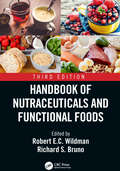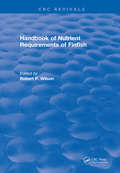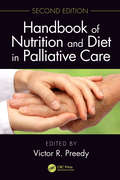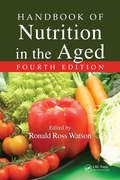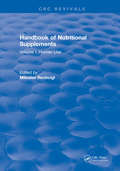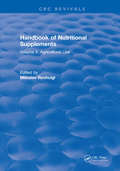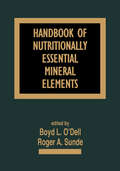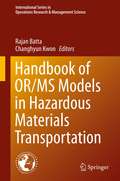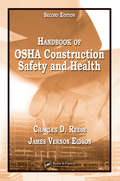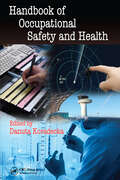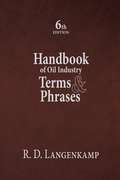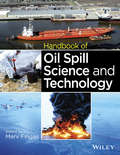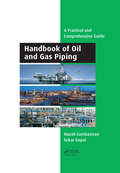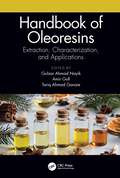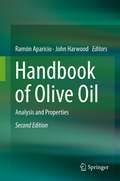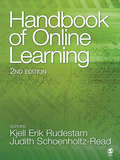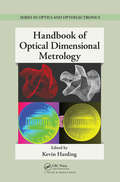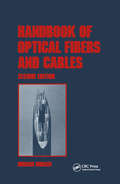- Table View
- List View
Handbook of Nutraceuticals and Functional Foods
by Robert E.C. Wildman and Richard S. BrunoThe field of functional foods along with their bioactive food components has grown tremendously over the past decades. Often guided by hypothesis-generating epidemiological observations, discoveries from basic science studies and controlled trials in humans have provided critical evidence to help establish an optimal diet that alleviates chronic disease risk. These advances have also driven efforts by the food and nutraceutical industries to establish and market health claims, formulate extra-value foods, and even generate new health foods for human benefit.Handbook of Nutraceuticals and Functional Foods, Third Edition, compiles the data from experts in the field that potentiates the already established credibility of the earlier editions. In its three-section format, it provides an authoritative summary of the prophylactic and/or medicinal benefits of natural foods and their constituents that are linked to favorable health outcomes. Beginning with an overview of the field and associated regulations, each chapter describes the chemical properties, bioactivities, dietary sources, and evidence of these health-promoting dietary constituents.Features:• Summarizes plant- and animal-based functional foods and their bioactive components• New chapters on cannabidiol and scientific, legal, and regulatory considerations; green tea and nutraceutical applications; and herbal nutraceuticals and insulin resistance• Includes information on functional food beverages including coffee, green tea, and dairy milk• Discusses antioxidant and anti-inflammatory activities of vitamin E, anthocyanins and other (poly)phenolic compounds, and carotenoids• Provides an update on the health benefits and requirements of protein and performance and therapeutic application and safety of creatine.
Handbook of Nutraceuticals and Natural Products
by Preetha Balakrishnan Sreerag GopiAn essential treatment of nutraceuticals and natural products, their preparation techniques, and applications In Handbook of Nutraceuticals and Natural Products: From Concepts to Application, a team of distinguished researchers delivers a one-stop resource describing the preparation techniques and functional uses of nutraceuticals and natural products with a focus on the technologies involved. The book includes coverage of the biological, medicinal, and nutritional properties and applications of functional foods, as well as the advanced technologies used in the extraction and functionalization of nano components and the nanomaterial and nanochemical aspects of the products. The authors discuss developmental research as well as user-level benefits of nutraceuticals and natural products and thoroughly review the market analyses, quality assurance processes, and regulations relevant to nutraceuticals and natural products. They also cover: Thorough introductions to nutraceuticals, functional foods, liposomal technology, prebiotics, and lycopene and its active drug delivery Comprehensive explorations of nutraceutical compounds from marine microalgae and poly lysine as an antimicrobial agent Practical discussions of a nutraceuticals approach to treating cancer-cachexia and early life nutrition and epigenetics In-depth examinations of encapsulation and delivery of nutraceuticals and bioactive compounds by nanoliposomes and tocosomes as promising nanocarriersPerfect for chemists, biochemists, food scientists, and materials scientists, Nutraceuticals and Natural Products: From Concepts to Application will also earn a place in the libraries of medical scientists working in academia or industry, as well as nutritionists, dietitians, and biochemistry graduate students studying nutraceuticals.
Handbook of Nutrient Requirements of Finfish (CRC Press Revivals)
by Robert P. WilsonA one-of-a-kind book for researchers interested in finfish nutritionHandbook of Nutrient Requirements of Finfish provides a summary of qualitative and quantitative nutrient requirements for almost all cultured finfish for which a significant amount of nutritional information now exists. Information is presented by species and includes how each species is cultured, an index of production, regional locations where each species is being cultured, examples of purified or test diets and special conditions required for laboratory studies, nutrient requirements and practical diet formulation. Discussions of special diets and feeding practices are included for certain species. This book will be a useful guide for students, researchers, practicing nutritionists, aquaculturists, and feed manufacturers interested in fish nutrition.
Handbook of Nutrition and Diet (Food Science and Technology)
by Babasaheb B. DesaiThis handbook of nutrition and diet provides information on food nutrients and their functions; food safety and distribution; food composition, consumption and utilization; adequacy of diet; and the nutritional management of diseases and disorders. It also discusses the effects of nutrition and diet on diseases of the bones, teeth, hair, kidneys, l
Handbook of Nutrition and Diet in Palliative Care, Second Edition
by Victor R. PreedyHandbook of Nutrition and Diet in Palliative Care, Second Edition, is a comprehensive guide, providing exhaustive information on nutrition and diet in terminal and palliative care. It covers physical, cultural and ethical aspects, bridging the intellectual divide in being suitable for novices and experts alike. Following in the tradition of its predecessor, chapters contain practical methods, techniques, and guidelines along with a section on applications to other areas of palliative care. Each chapter features key facts highlighting important areas, summary points, and ethical issues. FEATURES • Use of cannabinoids in palliative nutrition care • Pain control in palliative care • Communications in palliative/end-of-life care: aspects of bad news • Anorexia in cancer: appetite, physiology, and beyond • Palliative care in severe and enduring eating disorders • Linking food supplementation and palliative care in HIV • Eating-related distress in terminally ill cancer patients and their family members • Palliative care of gastroparesis • Preoperative nutrition assessment and optimization in the cancer patient • Childhood leukemia, malnutrition, and mortality as components of palliative care • End-of-life decisions in persons with neurodevelopmental disorders • Resources: listing web sites, journals, books and organizations
Handbook of Nutrition and Food
by David Heber Johanna T. Dwyer Carolyn D. BerdanierThe new edition of the Handbook of Nutrition and Food follows the format of the bestselling earlier editions, providing a reference guide for many of the issues on health and well being that are affected by nutrition. Completely revised, the third edition contains 20 new chapters, 50 percent new figures. A comprehensive resource, this book is a reference guide for many of the issues on health and well being that are affected by nutrition. Divided into five parts, the sections cover food, including its composition, constituents, labeling, and analysis; nutrition as a science, covering basic terminology, nutritional biochemistry, nutrition and genetics, food intake regulation, and micronutrients; nutrient needs throughout the human life cycle; assessment of nutrient intake adequacy; and clinical nutrition, from assessments to a wide variety of disease and health topics.
Handbook of Nutrition in the Aged
by Ronald Ross WatsonDetailed Review of Nutritional Therapies Used to Combat Elderly Health IssuesThe combination of the aging baby-boomer generation and their increased longevity has been fortunately met with increased research and greater understanding of health promotion and disease prevention in the elderly. Handbook of Nutrition in the Aged: Fourth Edition shares
Handbook of Nutritional Supplements: Volume I: Human Use (Crc Series In Nutrition And Food)
by Miloslav RechciglThe Handbook is composed of two parts, the first volume covering supplements for human usewhile the second volume is devoted to agriculture supplements. This volume, relating to food supplements for human use, is organized on the basis of raw materials utilized in their production, as well as on the basis of target groups for which they are intended.
Handbook of Nutritional Supplements: Volume II, Agricultural Use
by Miloslav RechciglThe Handbook is composed of two parts, the first volume covering supplements for human usewhile the second volume is devoted to agriculture supplements. This volume, relating to agriculture supplements, covers various food byproducts and nutritional and other food supplements used in animal feeding. In addition, it also includes information on nutrition supplements for plants.
Handbook of Nutritionally Essential Mineral Elements (Clinical Nutrition in Health and Disease)
by Boyd L. O’Dell Roger A. Sunde"Offers comprehensive, definitive information on all of the essential mineral elements--focusing on biochemical and physiological processes. Describes in detail the function of the nutritionally necessary elements revealed through the latest techniques in molecular biology as well as traditional research methods."
Handbook of Nuts: Herbal Reference Library (Herbal Reference Library #4)
by James A. DukeOver one hundred of the world's most important species of nuts are systematically accounted for in this informative handbook. The text defines nuts and discusses their economic and nutritional value. For easy reference, there is an illustrated account of each nut by species, arranged alphabetically by scientific name. Each account includes the family name, several colloquial names, and paragraphs on uses, folk medicine, chemistry, germplasm, distribution, ecology, cultivation, harvesting, yields, energy, and biotic factors.Chapters Describe:UsesFolk medicineChemistryGermplasmDistributionEcologyCultivationHarvestingYields and economicsEnergyBiotic factors
Handbook of OR/MS Models in Hazardous Materials Transportation
by Rajan Batta Changhyun KwonThe Pipeline and Hazardous Materials Safety Administration of the U.S. Department of Transportation defines hazardous materials (hazmat) as a substance or material capable of posing an unreasonable risk to health, safety, or property when transported in commerce. Hazmat accidents can result in significant impact to the population (death, injuries) and damage to the environment (destroyed or damaged buildings and infrastructure). Further, hazmat, especially explosive materials, can potentially be used by terrorists to attack civilians or to destroy critical infrastructure. This handbook provides models from Operations Research and Management Science that study various activities involving hazmat transportation: risk assessment, route planning, location decisions, evacuation planning, and emergency planning for terrorist attacks. There are two important research areas in hazmat transportation that are widely studied in the literature: risk assessment and shipment planning. In the risk assessment area, important issues include measurement of accident probabilities and consequences in hazmat transport. Example works in the risk assessment area include modeling risk probability distribution over given areas, considering hazmat types and transport modes, and environmental conditions. The first half of this handbook covers the two fields of risk assessment and shipment planning, while the second half of this handbook provides useful models and insights on other important issues including location problems for undesirable facilities, network interdiction, terrorist attack, and evacuation.
Handbook of OSHA Construction Safety and Health
by Charles D. Reese James Vernon EidsonA practical guide for eliminating safety and health hazards from construction worksites, the Handbook of OSHA Construction Safety and Health addresses the occupational safety and health issues faced by those working in the construction industry. The book covers a vast range of issues including program development, safety and health program implemen
Handbook of Occupational Safety and Health
by S. Z. MansdorfA quick, easy-to-consult source of practical overviews on wide-ranging issues of concern for those responsible for the health and safety of workers This new and completely revised edition of the popular Handbook is an ideal, go-to resource for those who need to anticipate, recognize, evaluate, and control conditions that can cause injury or illness to employees in the workplace. Devised as a “how-to” guide, it offers a mix of theory and practice while adding new and timely topics to its core chapters, including prevention by design, product stewardship, statistics for safety and health, safety and health management systems, safety and health management of international operations, and EHS auditing. The new edition of Handbook of Occupational Safety and Health has been rearranged into topic sections to better categorize the flow of the chapters. Starting with a general introduction on management, it works its way up from recognition of hazards to safety evaluations and risk assessment. It continues on the health side beginning with chemical agents and ending with medical surveillance. The book also offers sections covering normal control practices, physical hazards, and management approaches (which focuses on legal issues and workers compensation). Features new chapters on current developments like management systems, prevention by design, and statistics for safety and health Written by a number of pioneers in the safety and health field Offers fast overviews that enable individuals not formally trained in occupational safety to quickly get up to speed Presents many chapters in a "how-to" format Featuring contributions from numerous experts in the field, Handbook of Occupational Safety and Health, 3rd Edition is an excellent tool for promoting and maintaining the physical, mental, and social well-being of workers in all occupations and is important to a company’s financial, moral, and legal welfare.
Handbook of Occupational Safety and Health (Human Factors and Ergonomics)
by Danuta KoradeckaOccupational safety and health- safe work in a safe environment. The challenge, of course, is how to make this happen and make it happen economically. A comprehensive study presenting the state of the art in the field, Handbook of Occupational Safety and Health provides a wide range of methods along with specific criteria for assessing hazard and e
Handbook of Oil Industry Terms & Phrases
by Robert D Langenkamp R. Dobie LangenkampUpdated after two decades, the new 6th Edition of the Handbook of Oil Industry Terms & Phrases combines a father/son author team whose experience in the petroleum industry spans more than 75 years. R. Dobie Langenkamp offers a fresh set of terms and phrases introduced to the industry over the past 20 years, and still includes many historical references from the early days of the industry. The new edition adds more than 500 new terms and reflects the growth of oil exploration overseas, the emergence of national oil companies, and increased complexity of deal making.
Handbook of Oil Spill Science and Technology
by Merv FingasProvides a scientific basis for the cleanup and for the assessment of oil spillsEnables Non-scientific officers to understand the science they use on a daily basisMulti-disciplinary approach covering fields as diverse as biology, microbiology, chemistry, physics, oceanography and toxicologyCovers the science of oil spills from risk analysis to cleanup and through the effects on the environmentIncludes case studies examining and analyzing spills, such as Tasman Spirit oil spill on the Karachi Coast, and provides lessons to prevent these in the future
Handbook of Oil and Gas Piping: a Practical and Comprehensive Guide
by Murali Sambasivan Sekar GopalThe objective of this practical oil and gas piping handbook is to facilitate project management teams of oil and gas piping related construction projects to understand the key requirements of the discipline and to equip them with the necessary knowledge and protocol. It provides a comprehensive coverage on all the practical aspects of piping related material sourcing, fabrication essentials, welding related items, NDT activities, erection of pipes, pre-commissioning, commissioning, post-commissioning, project management and importance of ISO Management systems in oil and gas piping projects. This handbook assists contractors in ensuring the right understanding and application of protocols in the project. <P><P>One of the key assets of this handbook is that the technical information and the format provided are practically from real time oil and gas piping projects; hence, the application of this information is expected to enhance the credibility of the contractors in the eyes of the clients and to some extent, simplify the existing operations. Another important highlight is that it holistically covers the stages from the raw material to project completion to handover and beyond. This will help the oil and gas piping contractors to train their project management staff to follow the best practices in the oil and gas industry. Furthermore, this piping handbook provides an important indication of the important project-related factors (hard factors) and organizational-related factors (soft factors) to achieve the desired project performance dimensions, such as timely completion, cost control, acceptable quality, safe execution and financial performance. Lastly, the role of ISO management systems, such as ISO 9001, ISO 14001 and OHSAS 18001 in construction projects is widely known across the industry; however, oil and gas specific ISO quality management systems, such as ISO 29001, and project specific management systems, such as ISO 21500, are not widely known in the industry, which are explained in detail in this handbook for the benefit of the oil and gas construction organizations. <P><P>Features: <li>Covering the stages from the raw material to project completion, to handover and beyond <li>Providing practical guidelines to oil and gas piping contractors for training purposes and best practices in the oil and gas industry <li>Emphasizing project-related factors (hard factors) and organizational-related factors (soft factors) with a view to achieve the desired project performance <li>Highlighting the roles of ISO management systems in oil and gas projects.
Handbook of Oleoresins: Extraction, Characterization, and Applications
by Gulzar Ahmad NayikAn Oleoresin represents the true essence of spices enriched with volatile and non-volatile essential oil and resinous fractions. The oleoresin represents the wholesome flavor of the spice, a cumulative effect of the sensation of smell and taste. Therefore, it is designated as "true essence" of the spice and can replace spice powders in food products without altering the flavor profile. Our earth comprises a plethora of spices that have carved a niche in the global market in medicinal and health-related food products. These spices play a dual role as a food ingredient and a therapeutic agent preventing various diseases. This industry has acquired tremendous attention not only from consumers but also from scientific communities, and various food manufacturing organizations. Handbook of Oleoresins: Extraction, Characterization, and Applications is a snapshot of information on oleoresins—production, composition, properties, applications (medicinal & health properties), and more. It is designed to be a practical tool for the various professionals who develop and market spices and oleoresins Key Features: Contains comprehensive information on the major oleoresins of the world Dicusses the extraction and characterization of major spice oleoresins Covers the safety and toxicity of oleoresins Sheds light on relationship between oleoresins and health benefits The world is moving towards natural products. Spices lend color, taste, and flavor, and oleoresins are good source of antioxidants and have preservative as well as therapeutic power. Therefore it is important to understand and document the chemistry, characterization, properties and applications of oleoresins, as found in this handbook.
Handbook of Olive Oil
by John Harwood Ramón AparicioThe Handbook of Olive Oil presents an up-to-date view of all aspects of olive oil. It is written from an inter-disciplinary point of view and will be of use in research and development as well as in routine laboratory and process operations. This second edition includes new chapters devoted to genetic studies and agronomic aspects of new orchards and cultivars, which, in combination with the most recent biochemical studies and technological developments, explain the unique chemical composition of olive oil. The analytical aspects of the first edition are now described in six new chapters focused on the chemical compounds responsible for olive oil traceability and sensory perceptions (odor, color, and taste) utilizing chromatographic, spectroscopic, and in-tandem techniques. Nutritional and sensory aspects are the basis for the current success of virgin olive oil among consumers, and this new edition re-analyzes in two new chapters the role of lipids, in general, and olive oil, in particular, in nutrition and health. In addition, the methodologies developed for determining sensory quality, olive oil oxidation, and deep-frying are extensively described and discussed. The role of consumers in olive oil studies of marketing and acceptability is covered in a new chapter. This second edition has not ignored the fact that the popularity of olive oil has made it a preferred target for fraudsters. Deliberate mislabeling or mixtures containing less expensive edible oils are topics described in depth in two chapters devoted to traceability and adulteration. There is also a new chapter focused on the olive refining process, which is a relevant activity in the olive oil world, and another chapter displaying tables of chemical and sensory information from olive oils produced all over the world. The book is written at two levels: the main level is structured as a tutorial on the practical aspects of olive oil. A second, more methodological level, is intended for specialists in the different sciences that contribute to olive oil studies (biochemistry, chemistry, physics, statistics etc). This edition also details changes that are needed in different disciplines in order to overcome current problems and challenges.
Handbook of Online Learning
by Kjell Erik Rudestam Judith Schoenholtz-ReadThe Handbook of Online Learning is a comprehensive reference text for teachers and administrators of online courses and programs. It presents a discussion of the conceptual and theoretical foundations of online learning along with an exploration of practical implementation strategies. New and Ongoing FeaturesEmphasizes interactive teaching/learning strategies – challenging readers to think differently about pedagogy Provides a strong theoretical base before discussing applications: Part I first presents the changing philosophies and theories of learning, while Part II covers implementation or the practice of online learning Offers several chapters that deal with the issues related to the growing corporate online learning environment Includes twelve NEW articles on the latest issues such as psychology of online learning, training faculty, digital libraries, ethical dimensions in online learning, legal issues, course management systems and evolving technologies. key articles retained from current edition are revised and updated to reflect current trends and changes in the field Praise for the First Edition"The Fielding Institute authors apply an impressive wealth of organizational management theory and experience in their analyses of computer-mediated teaching and learning. The result is an enjoyable-to-read, fresh and lively book, delivering an abundance of ideas about how to establish a supportive learning environment, design a well structured course and manage electronically mediated dialog, -- in other words, how to successfully facilitate learning in the new context of on-line distance education."—Michael G. Moore, Pennsylvania State University and Editor, The American Journal of Distance Education "This book is a fascinating, comprehensive, revealing array of information about online learning. It is full of practical applications and significant implications for a future where online learning will play an increasingly larger role. It is essential for any library keeping up on online learning innovations." —Dr. Bernard J. Luskin, President and Co-CEO, GlobalLearningSystems, Inc. Visiting Professor, Claremont Graduate University"This book not only is that rare breed that addresses online learning in both higher education and corporate environments but every chapter is intriguing, informative, and accurately grounded. This book provides a comprehensive, timely, and informative look at online learning in higher education and corporate training settings. For an update on the state of e-learning in educational and training environments, simply read this book."—Curtis J. Bonk, Ph.D., Indiana University and Courseshare.com"Business and Learning have enjoyed a symbiotic relationship in our culture. The pace of change, however, has created separation between these two vital elements. The "Handbook of Online Learning" showcases the latest thinking and applications in learning delivery, and offers real promise that the gap is being bridged." —D.M. Verkest, AT&T Wireless Services, Vice-President-National Operations "The authors of this book are all experienced distance educators who know what the issues are: How are people engaged in teaching and learning at a distance "present" to one another? How do you create a community in the class? How can a teacher deal with an obstreperous student? What are the teaching/learning environments in universities and corporations as they affect distance education? The essays in this book inhabit the border where the idea of distance education meets the reality. The give practical advice and provide examples informed by both theory and experience."—Stanley Chodorow, Professor Emeritus, University of California, San Diego & Former CEO, California Virtual University
Handbook of Optical Dimensional Metrology (Series in Optics and Optoelectronics)
by Kevin HardingDue to their speed, data density, and versatility, optical metrology tools play important roles in today's high-speed industrial manufacturing applications. Handbook of Optical Dimensional Metrology provides useful background information and practical examples to help readers understand and effectively use state-of-the-art optical metrology methods
Handbook of Optical Engineering (Optical Science and Engineering)
by Daniel MalacaraThis handbook explains principles, processes, methods, and procedures of optical engineering in a concise and practical way. It emphasizes fundamental approaches and provides useful formulas and step-by-step worked-out examples to demonstrate applications and clarify calculation methods. The book covers refractive, reflective, and diffractive optical components; lens optical devices; modern fringe pattern analysis; optical metrology; Fourier optics and optical image processing; electro-optical and acousto-optical devices; spatial and spectral filters; optical fibers and accessories; optical fabrication; and more. It includes over 2,000 tables, flow charts, graphs, schematics, drawings, photographs, and mathematical expressions.
Handbook of Optical Fibers and Cables, Second Edition (Optical Science and Engineering #1)
by Hiroshi MurataThis work covers the history of optical communications, fibres and fiber cables, and compares optical fibres with other transmission media. It also discusses optical fibre materials, reliability and manufacture, illustrates the design, construction and properties of recent cables used for optical fibre, describes fibre splicing and presents automated fibre splicing machines, and more.
Handbook of Optical Interconnects (Optical Science and Engineering)
by Shigeru KawaiAs we reach the data transmission limits of copper wire and communications experts seek to bring the speed of long-haul fiber optics networks closer to access points, optical interconnects promise to provide efficient, high-speed data transmission for the next generation of networks and systems. They offer higher bit-rates, virtually no crosstalk, lower demands on power requirements and thermal management, and the possibility of two-dimensional channel arrays for chip-to-chip communication.The Handbook of Optical Interconnects introduces the systems and devices that will bring the speed and quality of optical transmission closer to the circuit board. Contributed by active experts, most from leading technology companies in the US and Japan, this outstanding handbook details various low-cost and small-size configurations, illustrates the discussion with more than 300 figures, and offers a look at the applications and future of this exciting and rapidly growing field. The book includes a detailed introduction to vertical cavity surface-emitting lasers (VCSELs); the use of optical interconnects in metropolitan, local-area, and access networks through FTTP (FTTH); and Jisso technologies, which are critical for developing low-cost, small-size modules.Driving down the size and cost of optical interconnects is vital for integrating these technologies into the network and onto microprocessors, and the Handbook of Optical Interconnects provides the knowledge and tools necessary to accomplish these goals.
